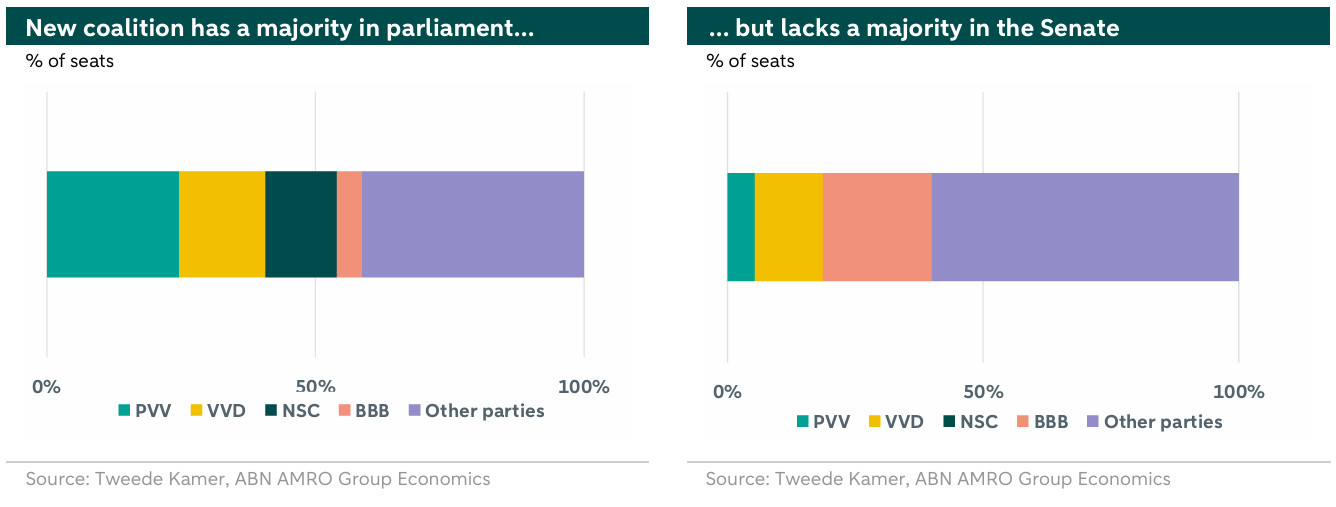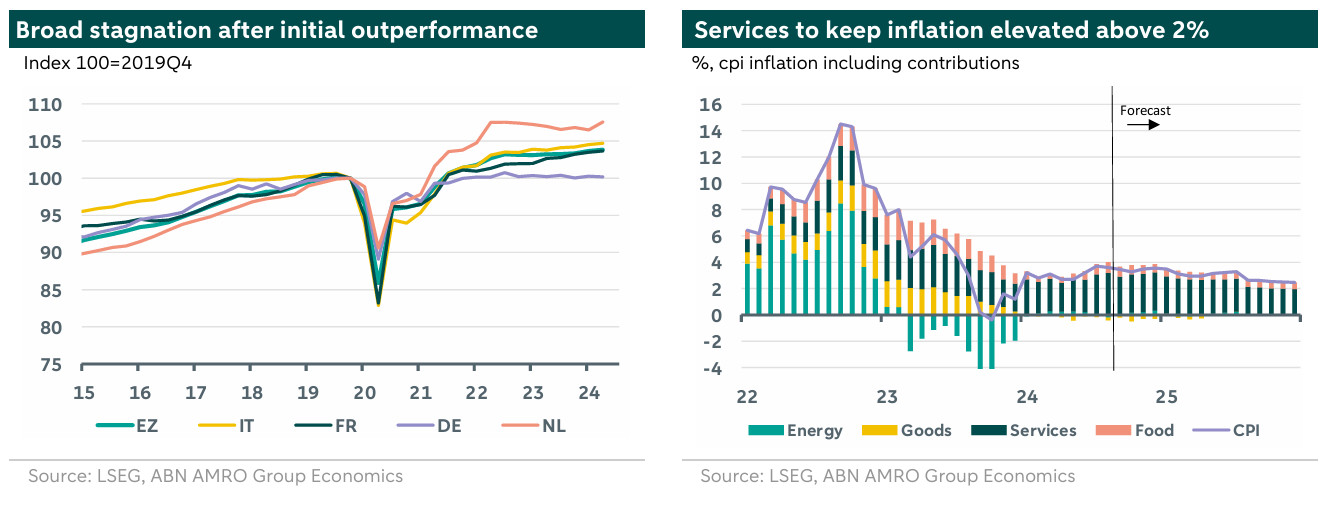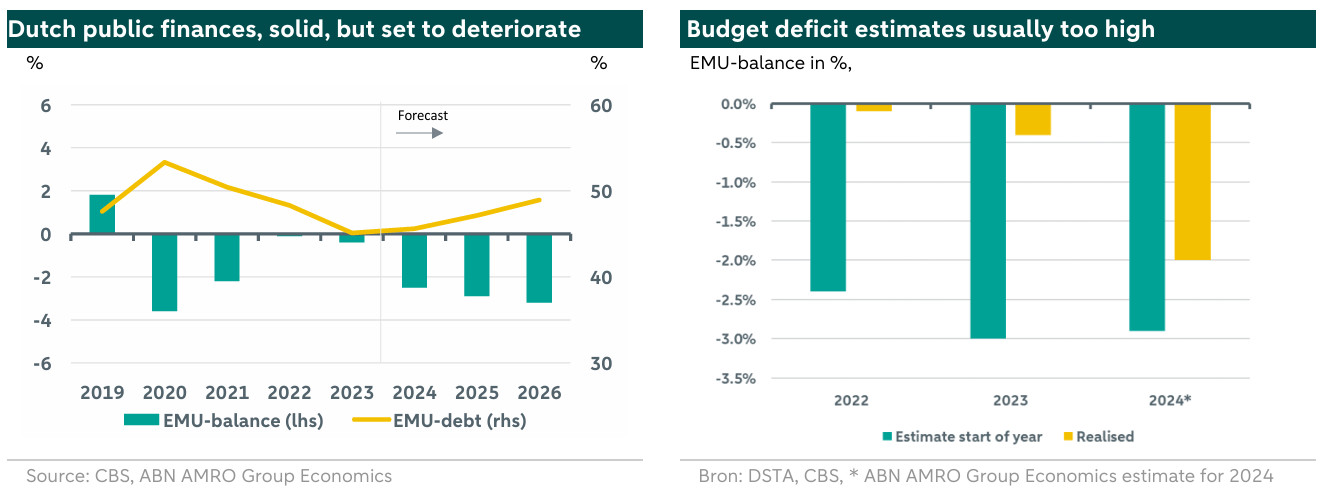Prinsjesdag 2024 - Budget day features little surprises

It has been a busy week in Dutch politics with the presentation of the 2025 budget today and the announcement of the new cabinet’s first term plans last week. The budget features among other topics additional measures to support household purchasing power. Helped by these measures, Dutch economic growth is set to normalize next year(s) on the back of rising real income. However, the measures will also see the budget deficit increase to 2.5% of GDP next year. We expect the total funding need to be around EUR 60bn, which is lower compared to 2024 as there is only one DSL maturing in 2025. Based on this estimate, we expect the DSTA to announce around EUR 35bn worth of DSL issues in 2025. In their first term, the Schoof I Cabinet focusses on curtailing migration, healthcare, housing and purchasing power and plans to cut spending on education, innovation and international cooperation. The current government is less pro-European compared to the previous government.

Jaap Teerhuis
Senior Fixed Income Strategist
Budget and policy plans: Short term gain, long term pain?
Today’s budget did not feature many surprises. It is the first budget of the incoming Schoof I government, which consists of election winner PVV (far-right), outgoing prime minister Rutte’s VVD (liberal centre-right) and newcomers the Farmer Citizen Movement (BBB, right) and New Social Contract (NSC, centre-right). Eye-catching subjects were: a smaller than anticipated purchasing power package for next year, with an additional tax bracket providing tax relief for middle income households. Furthermore the Dutch business climate is solidified by removing plans to scale back the tax ruling for expats – important for high-tech companies such as ASML. These measures alongside additional spending on defence, (Ukrainian) refugees and social security was partly offset by an increase in VAT for culture and books and a sizeable cut in spending on education and innovation funds. Overall, the budget for next year seems to favour short term spending over longer term investments as indicated in our previous note on the government’s plans.

Indeed, a much heard criticism on last Friday’s document in which the Schoof I government laid out its first term plans is that it seemed to focus on the short term. Main topics are migration – “aiming for the strictest migration policy ever” – as well as the ambition to drastically increase housing supply alongside more purchasing power relief in the coming years via for instance lower mandatory healthcare contributions. While policy on longer term issues facing the Dutch economy (labour market tightness, ageing) and challenges (reaching climate goals, reducing nitrogen emissions, very weak productivity trend) is either not concrete or absent.
Incoming government more at odds with EU than the previous government
In terms of international cooperation the Schoof I government is less warm towards the EU than the previous government. This was to be expected with outspoken anti-EU party the PVV as election winner. The policy ambitions are at odds with EU legislation and in any case EU solidarity. The government plans to cut Dutch contributions to the EU budget, although the most recent documents do not reiterate this. Furthermore the government is trying to get an opt-out to European migration policy. Also the Dutch government aims to lengthen current exceptions to environmental legislation for the Dutch agricultural sector. Lastly, the new government has indicated that it will more carefully evaluate EU initiatives, ensuring European legislation is necessary, feasible, and considerate of member states' differences.
Households support the economic recovery while inflation stays elevated
Dutch economic growth is set to gain more momentum in the coming quarters as rising real incomes will spur household consumption and the government will support growth via an expansive fiscal stance. Over the course of 2025 as interest rates decrease on the back of more ECB rate cuts we expect eurozone growth to increase, which will also increase demand for Dutch exports. We expect Dutch economic growth in 2024 to average 0.6% and rise to 1.3% in 2025, following growth of 0.1% in 2023. Contrary to the disinflation we see in the broader eurozone, Dutch disinflation is expected to be slower leading inflation to remain more elevated. High wage growth, leading to price rises in services slow the disinflationary trend. Dutch HICP inflation is expected to average 3.1% in 2024 and decline to 2.8% in 2025.

Government finances: large deficits set to push up the debt ratio
The multi-year trajectory of Dutch public finances is one of high deficits and an increasing debt ratio. Compared to the previous government’s plans, the structural budget deficit was reduced slightly. Still, in 2024 the deficit is expected to increase to -2.0% of GDP, to -2.5% of GDP in 2025 and -2.9% (1) of GDP in 2026 following a deficit of -0.4% of GDP in 2023.

Funding need 2025: Lower than 2024
The funding need of the Dutch state for a year is determined by three factors, namely the refinancing of maturing DSLs and DTCs and the cash deficit. For DSLs, only one DSL will mature next year (EUR 20bn) compared to two this year (EUR 33bn). Also, the money market position is expected to be lower at the end of this year (around EUR 20bn) compared to the year-end position of 2023 (EUR 25.5bn). As a result, there is expected to be around EUR 18bn less funding requirement for these factors. Estimating the cash deficit is more complicated because it depends on several factors that are difficult to predict. The EMU budget deficit is a key indicator to determine the cash deficit and, as the expected deficit for 2024 is about the same as this year's, it is likely that the cash deficit will be about the same as 2024. The chart above on the right shows that the EM budget deficit, as published by the DSTA in the Outlook for the next year, has been significantly higher than the realisation in recent years. This is mainly because the government spends less than budgeted, while tax collections are higher than expected. We expect the same for the current year. Incidentally, the DSTA takes this into account when determining the funding need. This implies that the cash deficit can be estimated at around EUR 20bn, which will bring the total financing requirement to around EUR 60bn. Based on this estimate, we expect the DSTA to announce around EUR 35bn worth of DSL issues in 2025. This is slightly lower compared to this year (EUR 40bn, where there is room to issue another new DSL in addition to the new 10-year DSL).
(1) This features a one-off payment of about 0.7% of GDP for military pensions.
